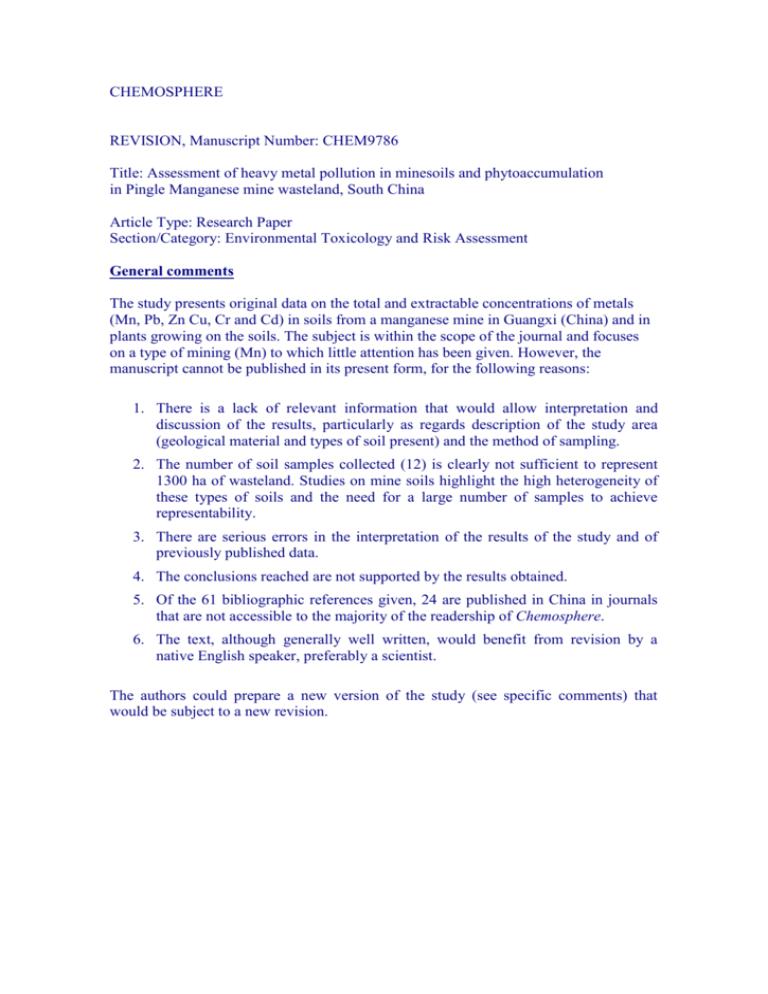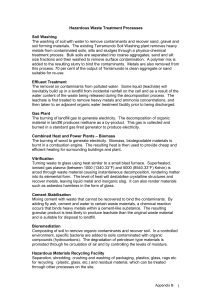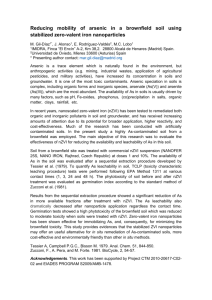Review comments
advertisement

CHEMOSPHERE REVISION, Manuscript Number: CHEM9786 Title: Assessment of heavy metal pollution in minesoils and phytoaccumulation in Pingle Manganese mine wasteland, South China Article Type: Research Paper Section/Category: Environmental Toxicology and Risk Assessment General comments The study presents original data on the total and extractable concentrations of metals (Mn, Pb, Zn Cu, Cr and Cd) in soils from a manganese mine in Guangxi (China) and in plants growing on the soils. The subject is within the scope of the journal and focuses on a type of mining (Mn) to which little attention has been given. However, the manuscript cannot be published in its present form, for the following reasons: 1. There is a lack of relevant information that would allow interpretation and discussion of the results, particularly as regards description of the study area (geological material and types of soil present) and the method of sampling. 2. The number of soil samples collected (12) is clearly not sufficient to represent 1300 ha of wasteland. Studies on mine soils highlight the high heterogeneity of these types of soils and the need for a large number of samples to achieve representability. 3. There are serious errors in the interpretation of the results of the study and of previously published data. 4. The conclusions reached are not supported by the results obtained. 5. Of the 61 bibliographic references given, 24 are published in China in journals that are not accessible to the majority of the readership of Chemosphere. 6. The text, although generally well written, would benefit from revision by a native English speaker, preferably a scientist. The authors could prepare a new version of the study (see specific comments) that would be subject to a new revision. Specific comments Coment 1. Introduction: Indicate the significance of RMB yuan and give an approximate equivalent in a reference currency (for example, dollars). 2. Materials and methods Include the relevant information about the geology and the soils in the zone in a description of the study area……………………… Indicate the surface area occupied by each of the zones in which the mine is divided (M, FTD, RTD and R)………………………… I think that the number of soil samples collected (12) is clearly not sufficient to represent 1300 ha of wasteland. Studies on mine soils highlight the high heterogeneity of these types of soils and the need for a large number of samples to achieve representability. How were the sampling sites within each zone and the sampling points within each site chosen? What is the surface area of the sampling area? What is the distance between sampling points?.................... Indicate where and how the plants samples were collected: whether samples were collected from a single plant or from several plants, whether the entire plant was sampled or only a part, how many samples were collected of each species and at each site …... Indicate the extraction method used for analysis of total phosphorus (TP). Indicate the form the results for TP refer to (elemental P, P2O5, PO43-,…). …………………………………………………… The authors do not state whether certified reference materials were included to check the percentage of recovery in the analysis of total metals in soils and plants ……………………. Omit the headings of sub-sections 2.4.1 and 2.4.2 Include the bibliographic reference for the “Chinese Environmental Quality Standard for Soils” ……………………………………….. References are not provided for the analytical methods used . Results The pH of the soil should be rounded to one decimal place The intervals of concentration of moderate class TN and OM should be given in accordance with the Chinese Soil Fertility Standard (NY/T 391-2000). The reference does not appear in the reference section The authors state that: “All the extractable metal fractions were below 5%, indicating a very low availability to plants”. This is not true as although the percentage of extractable metals is relatively low, the amount of bioavailable metal is very high, especially for Cd and Mn. In the text, Cd (3.55%) and Cr (0.19%) should read Cd (4.43%) and Cr (0.23%). Li et al, 2006b should be cited as Li et al, 2007 (date of publication of the journal) It is not true that the contamination indices (Pi and I-geo) follow the Line 48 99 105 119 121 133 136 143,154 155 183 187 197 198-199 206 same pattern. Only those obtained for Zn and Cu are comparable. They are not comparable for Pb or for Cr. The I-geo index for Cd is not given. Avoid repetition. It is not necessary to continually remind the reader what the Pi index is when it is explained in the previous paragraph. Delete the sentence “The difference was mainly attributed to the assessment criteria (natural soil background vs. soil quality standard) used (see Discussion).” Replace ND (not detectable) with “< limit of quantification” (e.g. <0.5 mg/kg). Which values were used in the statistical analysis when the value was ND? This should be explained in the statistical methods. The concentrations of Cr and Cd reached high levels in plants even though “ the bioavailability is low in relation to the total Cr”. The correct reference for Cao, 2001 is Cao and Chi, 2001. Establish a method of ordering the metals (alphabetical order, concentration… ). Follow the same order in the text, except with groups. Indicate where normal levels of heavy metals are found in plants. What type of plants does this refer to, what part of the plant, where the plants are growing….. 208-213 208-213 212 224 225 228 226-228 Discussion In this section the authors simply present a series of previously reported studies, without putting into perspective the results obtained in their own study. They also use vague terms such as “low” and “high”, without giving numerical values. Furthermore as most of the studies cited are in Chinese, they cannot be consulted by many of the readers of Chemosphere. In the first paragraph, for instance, 4 examples of Pb/Zn, Cu, Sn/Sb and Mn mines are given, but only data for Cu are provided. The authors indicate that the Pi index is widely used, but I understand that the standard reference values used to calculate them may vary depending on the particular study in question. What values were used in the cited studies? Do they coincide with those used in the present study? The authors state that: “The difference of the two assessments lies in that I-geo linked theoretically all “pollution contribution” to the soil background value only, not discriminating the natural lithogenic effect from anthropogenic contribution.” Does the Pi index make this discrimination? I understand that the I-geo index is more appropriate for making this discrimination, as it includes background levels of metals in natural soils in the area, and presumably over a similar geological substrate. All of the phytotoxicity data for metals given in this paragraph must be revised and compared with those given by other sources. Many 244-257 258-261 265-273 of the data in the list are taken from different sources, without any apparent underlying reason for including them. It is not clear whether the phytotoxic concentrations given correspond to the soil or the plants, or under what conditions they were obtained. For example, the authors give the total concentration of Cu in soil as 60-125 mg/kg, (Ross, 1994). However, they give the the phytotoxic thereshold as the concentration of Mn in plants that are very tolerant to metals and grown in hydroponic cultures (Paschke et al., 2005). Although I was unable to consult the paper of Jiang et al. (2001), I assume that the phytotoxic concentration of Cd given (70150 mg/kg) corresponds to the concentration in Brassica juncea, a metal tolerant plant that accumulates metals, and that was grown on soils contaminated with Cd and treated with EDTA (which increases the solubility of the metal), with the aim of using them as phytoextractors. Data such as 3-8 mg Cd/kg of soil or 1500-3000 mg Mn /kg soil are commonly given as critical levels for phytotoxicity (Ross, 1994). Finally, despite the attempt to revise the phytoxicity values, the results of the present study were not discussed in this context. The authors state that: “Conclusively the minesoils basically have a low metal-toxic potential to higher plants although they were assessed as heavily contaminated. The diverse mineland flora (over 30 plant species) and bearing fruit of planted peach trees in the restored area may support this.” This cannot be concluded either from the results of the present study or from discussion of the results of previously published studies. It is widely accepted that the total concentration of metals in the soil overestimates the risk of phytotoxicity, but in the present study, despite the low relative extractability of the metals, the bioavailable concentration of some metals is sufficiently high to surpass the thresholds of phytotoxicity. In addition, several studies have shown a poor correlation between bioavailable metals in soil and the metals absorbed by plants, as the latter can modify the soil conditions in the rhizosphere (increasing or decreasing the bioavailability of metals) and may develop specific physiological strategies for excluding or accumulating metals depending on the plant species. This part of the discussion should be shortened as these data were not provided in the present study. The conclusions reached in this paragraph are the opposite of the previously mentioned conclusions. References Provide the dates of publication of the journals, along with the volume and the corresponding pages, not the document available on-line. 274-281 291-294 330-349 442 493









